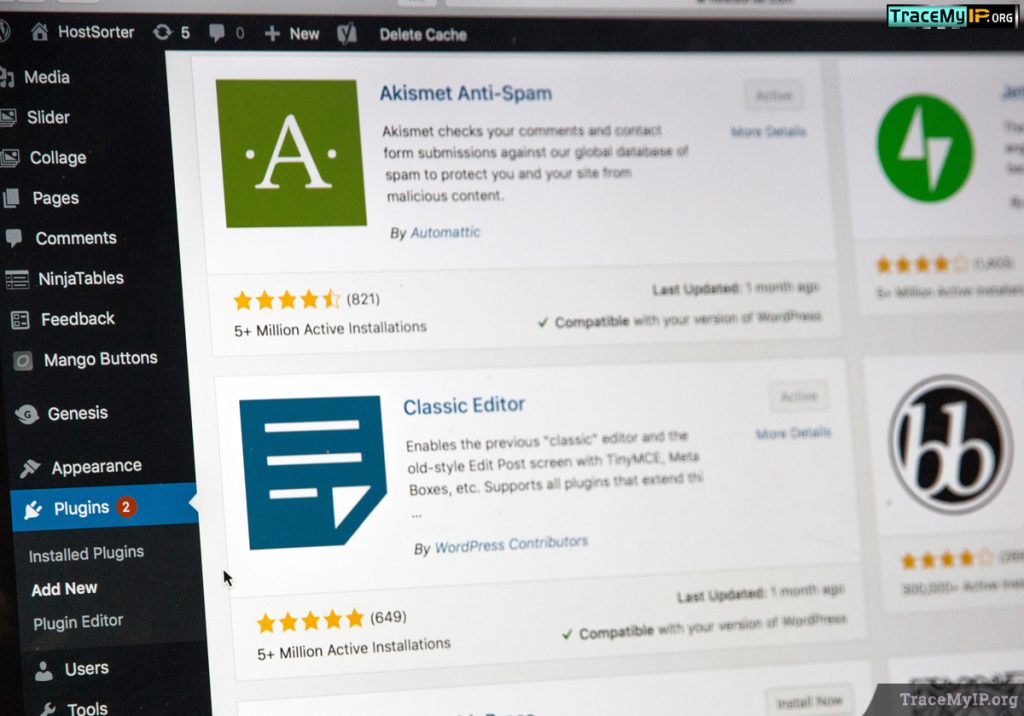Building a website using WordPress
Building a website using WordPress involves several steps. These steps will vary depending on your WordPress knowledge, existing utilization of website development methods, availability of skills dealing with the new software, and so on.
📈 Sign Up now to instantly track website visitors IPs!
Here’s a general concept of the process of building a website with WordPress
Domain and Hosting
 Choose and register a domain name for your website. This will be your website’s address (e.g., www.yourwebsite.com). Next, select a reliable hosting provider that will store your website’s files and make them accessible to visitors.
Choose and register a domain name for your website. This will be your website’s address (e.g., www.yourwebsite.com). Next, select a reliable hosting provider that will store your website’s files and make them accessible to visitors.
Install WordPress
Many hosting providers offer a one-click WordPress installation option, making it easy to set up. Alternatively, you can manually download the WordPress software from wordpress.org and install it on your hosting server.
Choose a Theme
Select a WordPress theme that aligns with the design and functionality you desire for your website. You can browse through thousands of free and premium themes available in the WordPress theme directory or from third-party marketplaces.
Customize the Appearance
Once you’ve chosen a theme, you can customize its appearance to match your brand or preferences. WordPress provides a user-friendly customization interface that allows you to modify colors, fonts, layouts, and more. You can also add a logo and customize the header and footer sections.
Install Plugins
 WordPress plugins are extensions that enhance the functionality of your website. Explore the vast plugin library to find and install plugins that add features such as contact forms, SEO optimization, social media integration, caching, security, and more. Install only the necessary plugins to keep your website lightweight and optimized.
WordPress plugins are extensions that enhance the functionality of your website. Explore the vast plugin library to find and install plugins that add features such as contact forms, SEO optimization, social media integration, caching, security, and more. Install only the necessary plugins to keep your website lightweight and optimized.
Create and Organize Content
Start creating your website’s pages and organizing its structure. WordPress uses a content management system, allowing you to easily add, edit, and organize content through a user-friendly editor. Create pages for your home, about, services, blog, and any other sections you want to include.
Customize Navigation
Set up your website’s navigation menu to provide easy navigation for visitors. You can create custom menus and add them to your header or footer areas. WordPress also allows you to create dropdown menus, rearrange menu items, and link to different sections or external websites.
Add Functionality with Widgets
Widgets are small content blocks that can be added to different areas of your website, such as sidebars or footers. You can use widgets to display recent posts, social media feeds, newsletter sign-up forms, search bars, and more. WordPress provides a range of default widgets, and plugins often add additional ones.
Optimize SEO
 Optimize your website for search engines to improve its visibility in search results. Install an SEO plugin, such as Yoast SEO or All in One SEO Pack, to help you optimize your pages’ meta tags, titles, descriptions, and keywords. These plugins also provide suggestions to enhance your content’s SEO.
Optimize your website for search engines to improve its visibility in search results. Install an SEO plugin, such as Yoast SEO or All in One SEO Pack, to help you optimize your pages’ meta tags, titles, descriptions, and keywords. These plugins also provide suggestions to enhance your content’s SEO.
Test and Launch
Before launching your website, thoroughly test its functionality, responsiveness, and compatibility across different devices and browsers. Ensure all links work correctly, forms submit data successfully, and the website is visually appealing. Once you are satisfied, make your website live by pointing your domain to your hosting server.
Maintain and Update
 Regularly update WordPress, themes, and plugins to ensure your website remains secure and performs optimally. Additionally, continue creating and updating content to keep your website fresh and engaging for visitors.
Regularly update WordPress, themes, and plugins to ensure your website remains secure and performs optimally. Additionally, continue creating and updating content to keep your website fresh and engaging for visitors.
This is a high-level overview of the process, and the specifics may vary depending on your hosting provider, chosen theme, and desired website functionality. However, WordPress provides a user-friendly interface and a vast community of resources to support you throughout the website-building process.
📄 🔗 Download the latest version of WordPress UnFiltered Stats plugin. To install, login to WordPress > Add Plugin > Upload Plugin or download from WP plugin directory.
🌍 Who visits your website? Sign Up now to find out instantly!
